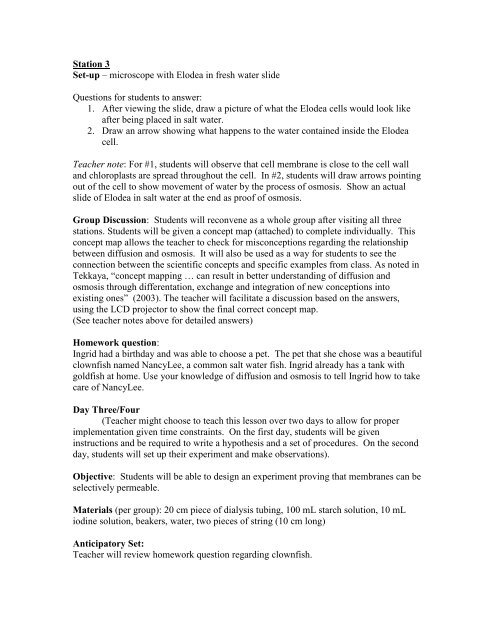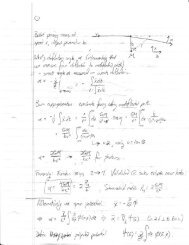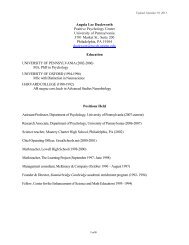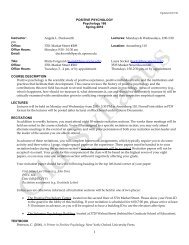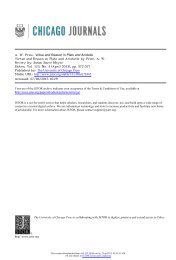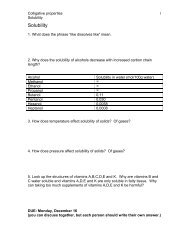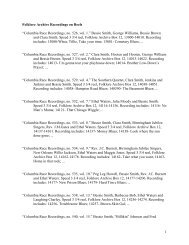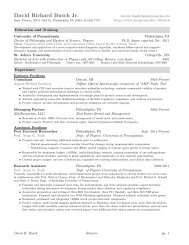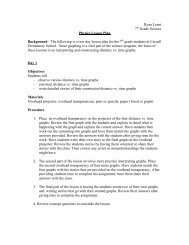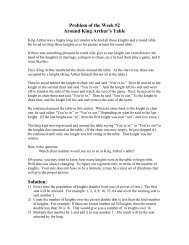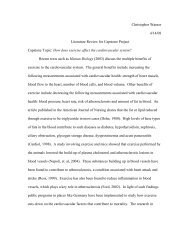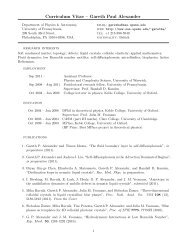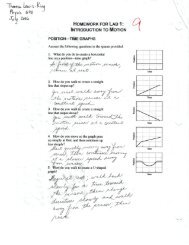Osmosis and Diffusion Audience - School of Arts & Sciences
Osmosis and Diffusion Audience - School of Arts & Sciences
Osmosis and Diffusion Audience - School of Arts & Sciences
You also want an ePaper? Increase the reach of your titles
YUMPU automatically turns print PDFs into web optimized ePapers that Google loves.
Station 3<br />
Set-up – microscope with Elodea in fresh water slide<br />
Questions for students to answer:<br />
1. After viewing the slide, draw a picture <strong>of</strong> what the Elodea cells would look like<br />
after being placed in salt water.<br />
2. Draw an arrow showing what happens to the water contained inside the Elodea<br />
cell.<br />
Teacher note: For #1, students will observe that cell membrane is close to the cell wall<br />
<strong>and</strong> chloroplasts are spread throughout the cell. In #2, students will draw arrows pointing<br />
out <strong>of</strong> the cell to show movement <strong>of</strong> water by the process <strong>of</strong> osmosis. Show an actual<br />
slide <strong>of</strong> Elodea in salt water at the end as pro<strong>of</strong> <strong>of</strong> osmosis.<br />
Group Discussion: Students will reconvene as a whole group after visiting all three<br />
stations. Students will be given a concept map (attached) to complete individually. This<br />
concept map allows the teacher to check for misconceptions regarding the relationship<br />
between diffusion <strong>and</strong> osmosis. It will also be used as a way for students to see the<br />
connection between the scientific concepts <strong>and</strong> specific examples from class. As noted in<br />
Tekkaya, “concept mapping … can result in better underst<strong>and</strong>ing <strong>of</strong> diffusion <strong>and</strong><br />
osmosis through differentation, exchange <strong>and</strong> integration <strong>of</strong> new conceptions into<br />
existing ones” (2003). The teacher will facilitate a discussion based on the answers,<br />
using the LCD projector to show the final correct concept map.<br />
(See teacher notes above for detailed answers)<br />
Homework question:<br />
Ingrid had a birthday <strong>and</strong> was able to choose a pet. The pet that she chose was a beautiful<br />
clownfish named NancyLee, a common salt water fish. Ingrid already has a tank with<br />
goldfish at home. Use your knowledge <strong>of</strong> diffusion <strong>and</strong> osmosis to tell Ingrid how to take<br />
care <strong>of</strong> NancyLee.<br />
Day Three/Four<br />
(Teacher might choose to teach this lesson over two days to allow for proper<br />
implementation given time constraints. On the first day, students will be given<br />
instructions <strong>and</strong> be required to write a hypothesis <strong>and</strong> a set <strong>of</strong> procedures. On the second<br />
day, students will set up their experiment <strong>and</strong> make observations).<br />
Objective: Students will be able to design an experiment proving that membranes can be<br />
selectively permeable.<br />
Materials (per group): 20 cm piece <strong>of</strong> dialysis tubing, 100 mL starch solution, 10 mL<br />
iodine solution, beakers, water, two pieces <strong>of</strong> string (10 cm long)<br />
Anticipatory Set:<br />
Teacher will review homework question regarding clownfish.


